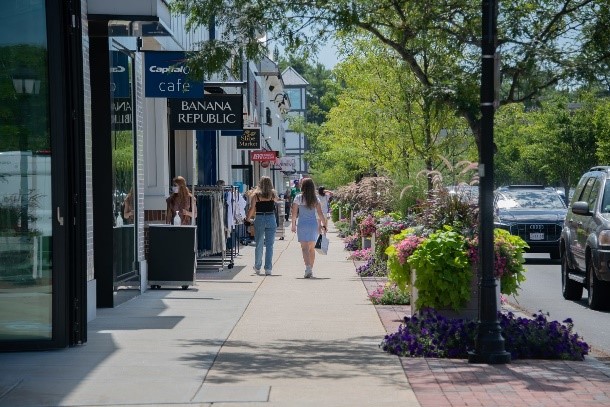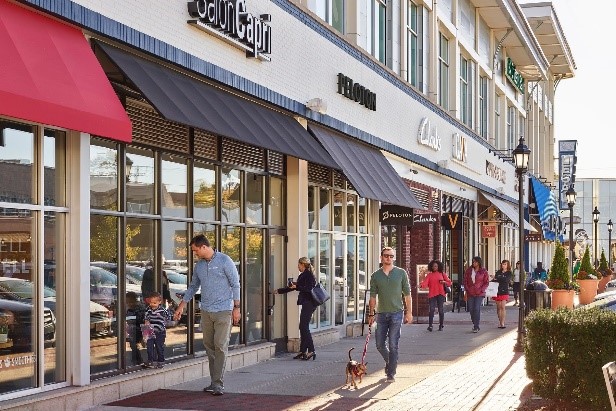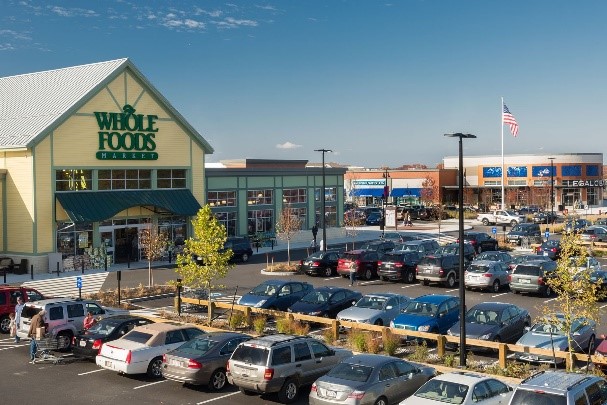Last fall, the Boston Planning and Development Agency (BPDA) forecasted that the proposed 161-acre Suffolk Downs Redevelopment project in East Boston and Revere would generate 72,316 new average daily vehicle trips at full build-out. The BPDA-approved Master Plan (for the Boston portion of the site) shows that the project (as currently proposed) would include up to 6,760 new parking spaces to accommodate those trips. To mitigate the effects of these increased driving trips and parking availability, Suffolk Downs developers are required to enter into a “Transportation Access Plan Agreement” with the city, holding them accountable to limit the number of vehicle trips generated by the project, and to fulfill a Go Boston 2030 (the City of Boston’s comprehensive transportation plan) goal of reducing the number of commuters driving alone to work by 50 percent. While there are more forecasted daily vehicle trips than parking spaces proposed, research increasingly shows that adding parking actually induces more driving. This surge in new trips could place stress on local roads, increase traffic congestion, raise safety concerns, and downplay walking, biking, and transit use, among other effects.
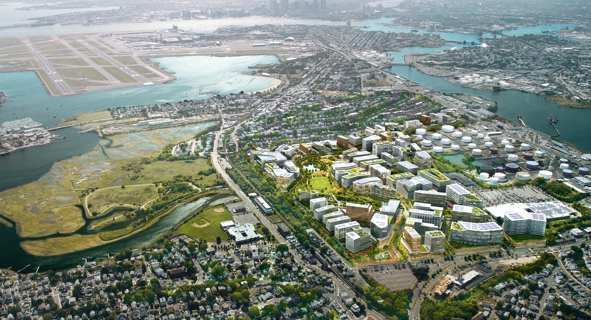
Suffolk Downs Redevelopment Project in Boston and Revere, MA.
So where do these trip forecasts come from? Why do mitigation efforts primarily focus on vehicle trips? And how can planners better understand these forecasts in order to plan livable, walkable communities? Recent Boston Region Metropolitan Planning Organization (MPO) work, Innovations in Estimating Trip Generation, explores all of these questions.
A Primer on Development Review and Trip Generation Rates
When any new development project is planned, a traffic impact study (TIS) (sometimes referred to as a transportation impact assessment or a traffic impact analysis) may be required if it meets certain thresholds (i.e. the amount of square footage for a large development). An early step in the permitting and development review process, a TIS evaluates the anticipated transportation effects of the project to inform planning decisions, such as parking supply or mitigation strategies. Those who prepare a TIS (typically traffic engineers, planners, or developers) commonly rely on trip generation data and analysis methods provided by the Institute of Transportation Engineers (ITE)’s Trip Generation Manual and Trip Generation Handbook to estimate the number of vehicle trips generated by the development site.
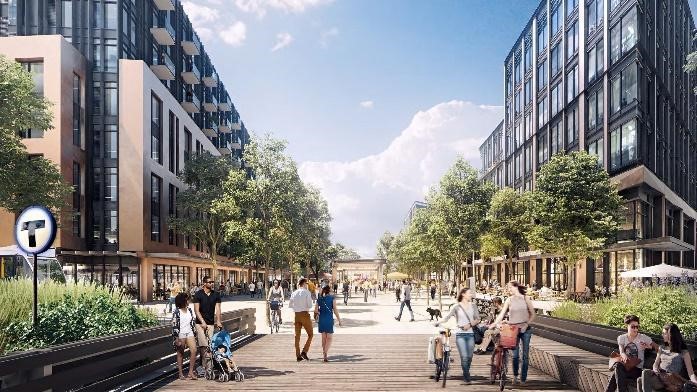
Rendering of Civic Plaza Belle Isle Square at Suffolk Downs.
However, it is well-documented in peer-reviewed literature that ITE-based methods are poorly suited for applications in denser, urban settings. These methods do not adequately account for key characteristics, such as multimodal travel options (i.e. walking, bicycling, ridesharing, micromobility, and public transit) and compact, mixed-use, or transit-oriented developments. Instead, the conventional methods have traditionally been geared toward single-use, vehicle-dependent projects commonly associated with suburban settings. As a result, the outputs can overestimate motor vehicle demand and exaggerate the anticipated traffic impacts. The trickle-down effect of this process can impact everyday living. Some potential consequences include
- inadequate support or funding for alternative transportation modes;
- an imbalance of transportation fees and exactions;
- an overbuilding of parking;
- an understating of the benefits of transit-oriented, mixed-use development; and
- heightened community resistance favoring isolated single-use development.
Note that the ITE is actively working to improve and modernize its trip generation data and methodologies. The organization states that users now have access to a significantly expanded and enhanced data set with more than 1,700 new data points—a 30 percent increase—and new urban, person-based trip data in the most recent edition of the Trip Generation Manual (ITE 2020).
No “Perfect” Approach, but a Promising Outlook
In summer 2020, Boston Region MPO staff set out to see what planners, both nationally and in the Boston region, are doing to account for all modes of transportation in their analyses. The two basic approaches in trip generation analysis are: 1) sophisticated adjustments to ITE rates, and 2) complete replacement of ITE rates with locally observed data. For the most part, both approaches rely on estimating “person-trips” and then applying “mode splits” from other data sources (such as the United States [US] Census Bureau’s American Community Survey [ACS] data) rather than specifically modeling trips by each mode. Person-trips are determined by counting the number of people at the project site, instead of counting the number of vehicles via local data collection. Mode splits represent the percentage of trips by each travel mode at the project site. While neither is perfect, these approaches represent a significant improvement over previous iterations that primarily analyzed, and therefore favored, personal vehicles. By shifting the focus on person-trips instead of vehicle-trips, planners can facilitate sustainable growth by permitting new development projects better suited to local contexts and travel preferences.
One of the case studies explored by staff (from MPO member Cambridge, Massachusetts) uses the second approach (“complete replacement of ITE rates with locally observed data”) in an innovative way that captures information on all mode types. Analysts aggregate data from the city’s Parking and Transportation Demand Management (PTDM) reports and multiply person-trips by mode split percentages, yielding estimates on how many people are traveling by which mode. PTDM reporting includes more than 45,000 people, representing 45 percent of Cambridge’s workforce. These reports have been a reliable source of data since the PTDM Ordinance was adopted more than 20 years ago. As a result, Cambridge no longer relies on the US Census Bureau’s ACS data and has made strides to achieve its goals for sustainable growth. Read more about Cambridge’s PTDM Ordinance.
Implementing Complementary Policies to Outdated Systems
While the primary focus of this study was to present innovations in estimating trip generation for nonautomobile modes, MPO staff were introduced to a wide variety of policy concepts integrally tied to the question of better trip generation analysis. Introducing new policies may help fill the gap for planning departments that face local resistance to best practices or have budget constraints. This is especially helpful given that staff’s comprehensive research and approximately 20 interviews with city planners and consultants across the country concluded that there is a major cost barrier to developing better methods that more accurately reflect modern city-goers’ transportation preferences. The lack of funding, dedicated staff, and political support can all undermine efforts to replace or at least improve upon existing practices.
Another important finding is that parking supply is a major force in trip generation analysis. The strong connection between parking supply and the number of vehicle trips, backed by research and interviews, established a direct relationship between policies that manage parking supply and policies that manage vehicle trip generation.
MPO staff discovered a chicken-and-egg issue; a familiar dilemma experienced by city planners and policymakers. Improved trip generation analysis allows planners and elected officials to explore policy frameworks that may not have been possible under the traditional ITE regime, but pursuing improved methods often relies on the existence of those policies. MPO staff look forward to working with municipalities to explore ways to promote better policy frameworks through another avenue in the future.
Next Steps: Enthusiastic Planners Ready for Solutions
MPO staff’s research revealed a broad interest in addressing the issues associated with the conventional trip generation rate methodology. Two key takeaways from the interviews with planners and consultants include
- an expressed hope that the results of this study and the other ongoing research efforts would be helpful in their work to improve municipal development review processes; and
- an enthusiasm about online, publicly available trip generation tools, such as those developed in San Francisco, CA and Washington, DC.
In the coming years, this research will inform and support several ongoing and upcoming efforts in the Boston region to improve the trip generation rates used to project travel by all modes. Collaborative work at the MPO, the Metropolitan Area Planning Council (MAPC), and the Massachusetts Department of Transportation (MassDOT) is currently underway, as is information-sharing with planners in other states and municipalities interested in improving their analysis methods.
Provision of improved analysis methods or trip generation rates by a regional- or state-level agency could prove to be a major benefit to the development of review practices in these municipalities. Hypothetically, the availability of such tools could allow municipal staff to negotiate the development process more confidently, basing their recommendations on research-backed best practices in the field. This report represents the first step in creating a framework for ongoing analysis to provide the tools needed at both the state and local levels.
More Information
Read the full report. Reach out to study authors Ariel Patterson (apatterson@ctps.org) or Sandy Johnston (sjohnston@ctps.org) with questions. Subscribe to the MPO’s email list and follow us on Facebook, Twitter, and Instagram @BostonRegionMPO.

